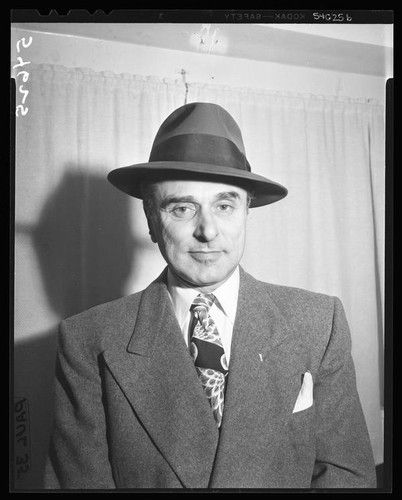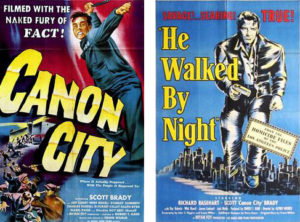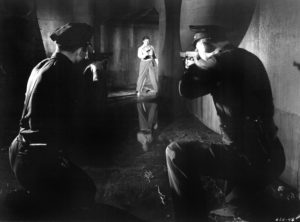
Mob fixer Johnny Rosselli is back in the spotlight
‘Handsome Johnny,’ best known for extorting Hollywood studios and making Las Vegas deals, also played key role in producing two classic noir movies

“Strategist.”
That word on Johnny Rosselli’s business card summed up his role as a Mob fixer whose colorful adult life, after knock-around teenage criminal years that took him from Boston to Los Angeles, included the gangster’s well-known participation with other Mafia heavyweights in a failed CIA plot to assassinate Cuban leader Fidel Castro during the JFK years.
In addition to this secretive high drama, Rosselli, a silky-smooth playboy thought by the FBI to be responsible for 13 murders, had his hand in various legal and illegal enterprises, including money-making ventures in Hollywood and Las Vegas. Rosselli even helped pave the way for reclusive billionaire Howard Hughes to purchase casino properties in Southern Nevada.
Along with constant FBI surveillance, though, there were more than a few difficulties in Rosselli’s life. He became caught up in a Hollywood extortion scandal, and later in a cheating scheme involving card players at the Friars Club of Beverly Hills.
All this came to an end in 1976, when the 71-year-old mobster was killed and stuffed into a 55-gallon oil drum later found floating in a bay near Miami.
Now, almost 45 years after this unsolved killing, there is renewed interest in Rosselli. (His given name at birth in Italy was Filippo Sacco, but he assumed the Rosselli alias after seeing that signature on Italian paintings he liked, according to historian and former Las Vegas casino executive Bill Friedman. The mobster’s forged birth name, Rosselli, is sometimes spelled with one “s.” Rosselli used the double “s” spelling on his business cards.)
One recent account of his life is Lee Server’s 2018 biography, Handsome Johnny: The Life and Death of Johnny Rosselli: Gentleman Gangster, Hollywood Producer, CIA Assassin.

Rosselli also is profiled in the latest issue of the Film Noir Foundation’s e-magazine, Noir City, exploring his involvement in Hollywood, including a role in producing action-packed crime capers. The Noir City article, “Handsome Johnny Takes Tinseltown,” was written by John Wranovics.
As interest in Rosselli gains some momentum, a movie based on Server’s book might be on the horizon. In an email, Server said he hopes to have news on that front soon. “There are talks going on,” he said.
Among other aspects of Rosselli’s eventful life, his time in Hollywood, and his association with high-ranking gangsters such as Al Capone and Jack Dragna, are interesting material for storytellers, setting him apart from some better-known Mob figures. Server noted that Rosselli carved out a special niche for himself in the film industry.
“Officially employed as an assistant purchasing agent, at a salary of sixty-five dollars a week, in reality he became a kind of producer-in-training,” Server said. “As a fully functioning member of organized crime, Johnny Rosselli’s relationship to Hollywood was unique and extraordinary.”
Server, whose previous books include biographies on Ava Gardner, Robert Mitchum and film director Samuel Fuller, said Rosselli moved between those two worlds — Hollywood and organized crime — “at the highest levels.”
“Just as he worked for the Mob bosses in Chicago, New York, Los Angeles, so was he a friend and adviser to the stars and big studio moguls in the movie capital,” Server said. “He seemed to some almost a creation of the movies, dashing, charismatic, perfectly groomed and sharply dressed. He retained many loyal and admiring friends in the film industry even after he’d been convicted of extorting the studios for millions of dollars.”
When he was released from federal prison in the 1940s after serving time for the extortion scandal, Rosselli’s parole stipulated that he find employment, Server said. The gangster headed back to Hollywood.
“A producer friend got him a job at the small Eagle-Lion Studios,” Server said. “Though uncredited, Rosselli would co-produce two features — dark, violent crime films of the sort we now call film noir.”
Server said it was generally thought that Rosselli “had merely put some money into the projects but was not otherwise involved.”
“My research and interviews showed that he had in fact been a key creative figure in the two films,” Server said. “Canon City, the first, is a great prison escape movie in a groundbreaking ‘neo-realist’ style. The second, He Walked By Night, is one of the great films noir from the classic period.”

In Los Angeles and Las Vegas, Rosselli dined at fine restaurants, often with different women, played golf, lounged by the pool. He threw money around. His brief marriages included one to film star June Lang and another to Marajen Stevick, the daughter of an Illinois newspaper owner. After Stevick’s marriage to Rosselli in Mexico was quickly annulled, the young woman’s father committed her to a psychiatric facility, where she underwent therapeutic electroshock treatment, according to Server.
Described by one informant as “sex crazy,” Rosselli was close to Judith Campbell Exner, a socially active California freelance artist who became involved with President John F. Kennedy and Chicago mobster Sam Giancana. Over time, when all this became public, these romances shined an accusatory spotlight on the troubling link between politics and organized crime.
During the course of his life, Rosselli spent a lot of time in Los Angeles, but he also lived in Las Vegas while orchestrating Mob deals, and was present in South Florida during clandestine CIA planning to topple Castro, but, according to Server, he always wanted to stay connected to moviemaking, despite not reaping huge gains in those endeavors.
“Among the surprises I encountered researching the book was the degree to which Johnny remained interested in making films,” Server said in the email. “Throughout the ’50s and ’60s he regularly optioned or commissioned screenplays he hoped to produce. He also came very close to producing an ‘adults only’ documentary on Las Vegas that would have featured nude showgirls, a kind of Mondo Cane project years in advance.”
Mob historian and author J. Michael Niotta, the great-grandson of Los Angeles crime boss Jack Dragna, said he believes a movie about Rosselli should be made, especially focusing on the Hollywood extortion scandal and the “Mr. Vegas” years.
“Like Jack’s life, there are too many decades and capers to go into all the details in just a couple of hours,” Niotta said via Facebook Messenger. “You would have to focus on a subject or period.”
Perhaps that focus can be gleaned from another of Rosselli’s business cards, this one identifying him as “Giovanni Rosselli, World Traveler, International Lover … and Last of the Big Spenders.”
Larry Henry is a veteran print and broadcast journalist. He served as press secretary for Nevada Governor Bob Miller, and was political editor at the Las Vegas Sun and managing editor at KFSM-TV, the CBS affiliate in Northwest Arkansas. Henry taught journalism at Haas Hall Academy in Bentonville, Arkansas, and now is the headmaster at the school’s campus in Rogers, Arkansas. The Mob in Pop Culture blog appears monthly.
Feedback or questions? Email blog@themobmuseum.org





